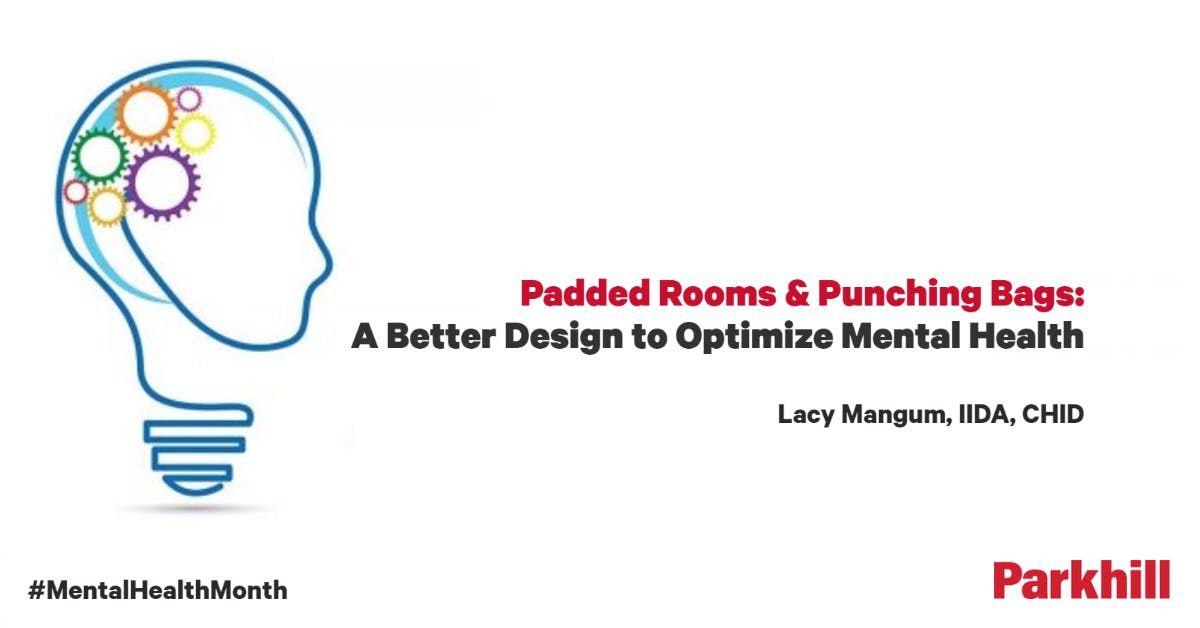University of Parkhill 2019-Padded Rooms and Punching Bags – A Better Design to Optimize Mental Health
Category: Architecture
Written By: Kristen West
Date: July 29, 2019

 According to the National Institute of Mental Health, nearly one in five U.S. adults lives with a mental illness. Those figures increase for adolescents between the ages of 13 and 18, where almost half the population lives with a mental, behavioral, or emotional disorder. So, what can we do as designers to challenge those statistics? Lacy Mangum, IIDA, an interior designer in Parkhill’s Healthcare Sector, originally shared her presentation “Padded Rooms & Punching Bags: A Better Design to Optimize Mental Health” at the University of Parkhill 2019 to help answer that question.
According to the National Institute of Mental Health, nearly one in five U.S. adults lives with a mental illness. Those figures increase for adolescents between the ages of 13 and 18, where almost half the population lives with a mental, behavioral, or emotional disorder. So, what can we do as designers to challenge those statistics? Lacy Mangum, IIDA, an interior designer in Parkhill’s Healthcare Sector, originally shared her presentation “Padded Rooms & Punching Bags: A Better Design to Optimize Mental Health” at the University of Parkhill 2019 to help answer that question.
We are designers, but first, we are people. “Be kind out there. Many people don’t ever step out and say, ‘Hey, I have anxiety or depression,’ so you may never know what someone is struggling with,” Lacy said. It all starts with awareness. “Be aware of your own mental health and those around you – your kids, your spouse, your co-workers. If you see someone that might be having trouble, reach out.”
With eight years of experience as a licensed vocational nurse, Lacy’s understanding of mental health in this setting shapes how Parkhill’s Healthcare Sector designs for optimized mental health operations and programming. “Design,” she said, “can improve our emotional responses. For example, we can use color, textures, lighting and more.”
Growing support for mental healthcare is taking a more prominent role in how we do our jobs as designers. “We’re finally starting to see mental health taken seriously at the reimbursement and treatment level from the insurance companies. More people are seeking and can afford treatment than ever before. There is a recognition that our youth are among the most troubled, and there are now more facilities dedicated to just pediatric, people under 18, treatment.”
Healthcare facilities aren’t our only opportunities for supporting mental health, however. Remember, nearly one in five adults in the U.S. lives with mental illness, and those figures increase for adolescents. “That means that every community we design for is an opportunity to provide spaces that support mental health. For example, in an office setting, you can use daylighting and give employees views outside. You can also create basketball courts, corn hole, or outdoor eating areas.”
“For prekindergarten-12th grade facilities, you have even more considerations, since people change a lot from the age of 4 to 18,” Lacy said. “For pre-K to fifth grade, most students don’t know how to deal with stress and express it through outbursts. We can design spaces within the classroom with soft seating, textured elements, and adjustable light to allow students to step away, cool down, and come back. As these kids grow, so does their ability to deal with some problems, but they are also more prone to self-harm. The same design criteria would apply but with the age group in mind.”
“As mental health awareness increases and the prevalence of depression, anxiety, etc. increases in our world, we need to be taking more active steps in identifying ways we can design spaces that positively influence our emotional state."


